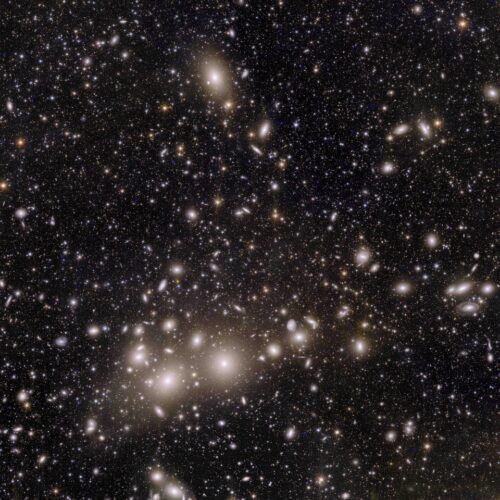Perseus cluster: ESA/Euclid/Euclid Consortium/NASA, image processing by J.-C. Cuillandre, G. Anselmi; CC BY-SA 3.0 IGO
For many years we have had two “tensions” in astronomy, and astronomers have disagreed about the value of the cosmological parameters. One is the Hubble stress, which revolves around H0, the Hubble constant, which represents the expansion rate of the universe, the other is the S8 stress (aka σ8 stress), which revolves around S8 and σ8, which represents the degree of clumpiness. matter, both normal matter and dark matter. But there’s a third voltage at play that’s less well-known but also revolves around the cosmological topic: the bulk flow voltage. This mass flow concerns the motions of galaxies in a part of the universe. As we know, galaxies are gravitationally connected to each other and are grouped into hierarchical systems from small groups (such as the Local Group with the Milky Way Galaxy and the Andromeda Galaxy) to clusters to superclusters. The bulk flow concerns the average velocity of galaxies as a result of the gravitational interaction between galaxies, not the velocity due to the expansion of the universe (see figure below).

Bulk flow diagram. Credit: Astrobites
The prevailing model of the universe is the ΛCDM model, which assumes that the universe has dark energy (Λ) and cold dark matter (CDM) that determine the evolution of the universe. Somewhere, the size of the mass flow depends on the distribution of both normal matter and dark matter and the gravitational force between these substances. ΛCDM makes a prediction about this and now it seems that that prediction deviates from the measurements. In this case, the difference between theory and practice, while the Hubble and S8 voltage concerns the difference between different measurements (and thus possibly with theory, if all measurements are correct).

In red, the local group velocity vectors of our supercluster. The vectors point to the Virgo and Fornax clusters, which are also part of the galactic supercluster. Credit: Wikimedia commons.
Some measurements show a larger bulk flux than predicted by ΛCDM. The solution could be that we in our local group live in “underdensity”, a relative void in the universe with fewer galaxies than in denser regions with more galaxies (see image below, yellow star indicates) and then settle in the middle of such a void or “void” because we are then in the middle of the vacuum, we experience a strong attraction towards the denser regions and this then results in a larger measured bulk flow.

Credit: Moritz Haslbauer and Zarija Lukic.
Infrared observations show that our Milky Way Galaxy is underdensity 600 megaparsecs in size, which is almost two billion light years – if there is an underdensity, as other studies indicate otherwise (fourth voltage?). It is also larger than predicted by the ΛCDM model. The underdensity also affects measurements of the Hubble constant, so it also has a relationship with the Hubble voltage. Another way to deal with mass flow stress is to come up with alternative models for ΛCDM. Recent studies have been conducted, for example Neutrino Hot Dark Matter (HDM), which includes massive sterile neutrinos and alternative gravity, MOND. Although this model gives good results with the measured bulk current, new problems arise, such as the excessive number of superclusters and the large voids you get. In short, there is still much work to be done here.
More information on the bulk flow stress can be read in the professional paper A simultaneous solution for the Hubble stress and bulk flow at 250 Mpc h-1 by Sergij Mazuurko, Indranil Banik, Pavel Kroupa, Moritz Haslbauer, published Monthly Bulletins of the Royal Astronomical Society.
Bron: Astrobites.

